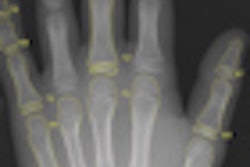
NEW YORK (Reuters Health), Sep 18 - Abnormal bone mineral density is common in children, adolescents, and young adults with epilepsy, Italian researchers have shown.
In the September issue of Epilepsia, Dr. Giangennaro Coppola, of Second University of Naples, and colleagues report on their assessment of bone mineral density in 96 patients with epilepsy and 63 controls between the ages of 3 and 25 years.
Among the patients, 47 (48.9%) had cerebral palsy and 66 (68.7%) had mental retardation. Fifty-seven patients (59.4%) could walk on their own, 11 (11.5%) walked with assistance, and 28 (29.1%) could not walk at all.
The average duration of epilepsy was 8.5 years, and the mean time on anticonvulsant therapy was 7.9 years.
Fifty-six patients (58.3%) had abnormal bone mineral density as measured by dual-energy x-ray absorptiometry (DEXA) scan of the lumbar spine (L1-L4), with osteopenia in 42 and osteoporosis in 14. There were significant differences between the patients and controls in bone mineral density, z score, and body mass index.
Furthermore, abnormal bone mineral density was significantly correlated with inability to walk independently, severe mental retardation, long duration of antiepileptic therapy, topiramate as adjunctive therapy, and less physical activity.
Cerebral palsy was also more frequently found in patients with abnormal bone mineral density, but not to a statistically significant extent.
Overall, the authors note, only two of the patients had "major clinical problems" related to low bone density, "which essentially consisted of fractures."
"To shed light on the individual role played by multiple independent risk factors that affect bone status, we are planning a study designed to compare the abnormal bone mineral density of epileptic patients ... not only with healthy children and adolescents, as we did in the present study, but also with nonepileptic children and adolescents, affected by cerebral palsy and mental retardation (both with and without autonomous gait)," the investigators maintain.
Epilepsia 2009;50:2140-2146.
Last Updated: 2009-09-16 18:39:03 -0400 (Reuters Health)
Related Reading
FDG-PET benefits findings in children with refractory epilepsy, July 2, 2009
Copyright © 2009 Reuters Limited. All rights reserved. Republication or redistribution of Reuters content, including by framing or similar means, is expressly prohibited without the prior written consent of Reuters. Reuters shall not be liable for any errors or delays in the content, or for any actions taken in reliance thereon. Reuters and the Reuters sphere logo are registered trademarks and trademarks of the Reuters group of companies around the world.

















